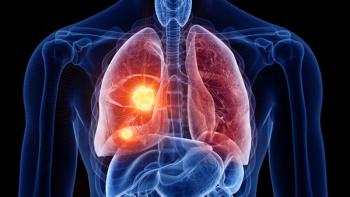
New Oral Agent Found Effective in Preventing Muscle Wasting in NSCLC
The results of two phase III trials reported at the 2014 MASCC/ISOO International Symposium on Supportive Care in Cancer have found that enobosarm, a first-in-class, nonsteroidal, oral selective androgen receptor modulator (SARM), led to an increase in lean body mass (LBM) compared with a decline in LBM observed with placebo for patients with non-small cell lung cancer (NSCLC).
Jeffrey Crawford, MD
The results of two phase III trials reported at the 2014 MASCC/ISOO International Symposium on Supportive Care in Cancer have found that enobosarm, a first-in-class, nonsteroidal, oral selective androgen receptor modulator (SARM), led to an increase in lean body mass (LBM) compared with a decline in LBM observed with placebo for patients with non-small cell lung cancer (NSCLC).
This LBM response was also associated with a benefit in physical function, survival, and quality of life, and enobosarm treatment was well tolerated by patients, according lead author Jeffrey Crawford, MD, from the division of medical oncology at Duke University Medical Center in Durham, North Carolina.
The two international phase III clinical trials clinical trials, G300504 and G300505, were designed to evaluate the efficacy and safety of enobosarm in preventing and treating muscle wasting in patients with NSCLC stages III/IV. Upon initiation of first-line chemotherapy, patients in the 504 study (POWER 1) received platinum with a taxane (mostly paclitaxel), and those in the 505 study (POWER 2) received platinum with a non-taxane (mostly gemcitabine). Patients in both trials received enobosarm (3 mg) or placebo.
The primary endpoints in both studies were LBM, as assessed by dual-energy x-ray absorptiometry (DEXA) and physical function, as assessed by stair climb power (SCP) at day 84. Secondary endpoints included the durability of effect (assessed at day 147) and overall survival (OS).
To be considered responders, patients had to either maintain or increase LBM and have a 10% or greater improvement in SCP. Nonresponders were defined as a patients not meeting the criteria for response or not having the Day 84 assessment, according to Crawford.
In the 504 study, at Day 84, the percentage of LBM responders was 30.4% in the placebo arm and 41.9% in the enobosarm arm (P = .036); the results for SCP also trended better with enobosarm (24.2% and 29.4%, respectively; P = .315) but did not reach significance.
In the 505 study, although the LBM responder rate trended better with enobosarm (37.9% vs 46.5%) the SCP responder rate did not (24.8% vs 19.5%), and neither endpoint was significantly different at Day 84.
Examining the results in all patients (as opposed to just responders) over time, in the 504 study, patients receiving placebo showed a decline in both LBM and SCP, whereas those patients in the enobosarm arm showed an increase in both endpoints.
Similar results were seen for the 505 study with the LBM endpoint, but according to Crawford, the SCP endpoint did “not pan out the same way it did [in 504]; we don’t see the same consistency we saw in the previous study, for reasons we still do not fully understand,” Crawford said. Despite this, he noted that there was a very consistent effect in both studies regarding change in lean body mass, which was highly significant in both studies.
Further results examining the change in LBM for both cases showed significant differences between the treatment groups in the 504 study at Day 84 (P <.0001) and Day 147 (P = .0003), and at the same timepoints in the 505 study (P =.008 and P = .0035, respectively), with increases in LBM observed in the enobosarm arm compared with decreases in the placebo arm. Crawford also noted that enobosarm was very well tolerated and that specific side effects related to enobosarm (as opposed to the chemotherapies used) were not observed.
Analyses on SCP change, survival, and quality of life according to LBM responses were also conducted. These additional results showed that LBM response was associated with improved SCP in both the 504 study (P = .0032) and the 505 study (P = 0.0336); similarly, LBM response was also associated with longer survival in both the 504 study (hazard ratio [HR] = 0.557; P = .0115) and the 505 study (HR = 0.545; P = .0069). In terms of quality of life; however, using intent to treat analysis, Crawford noted, “We did not see a clear signal between the arms of the study.”
Crawford JC, Johnston MA, Hancock ML, et al. Enobosarm, a Selective Androgen Receptor Modulator (SARM) Increases Lean Body Mass (LBM) in Advanced NSCLC Patients; Updated Results of Two Pivotal, International Phase 3 Trials. Presented at the MASCC/ISOO International Symposium on Supportive Care in Cancer. Miami, FL. June 26-28, 2014. Abstract MASCC-0546.
Newsletter
Knowledge is power. Don’t miss the most recent breakthroughs in cancer care.































































































